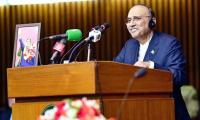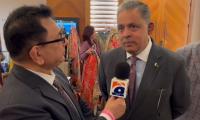The post-1857 period was a depressing era for the Indians. A large number of freedom fighters were either killed in the War of Independence of 1857 or imprisoned and hanged to death. The voices of freedom were stifled through brutal state power. These times were conducive for Christian missionaries.
A number of Indians who belonged to lower socio-economic backgrounds were lured into converting to Christianity. There were deliberate attacks on Islam and the Prophet of Islam (pbuh) by Western writers. The doors of government jobs were closed for Muslims. This situation forced the proponents of freedom to revisit their strategy of direct confrontation.
People like Muhammad Qasim Nanotvi and Rashid Ahmad Gangohi, who actually took part in the 1857 war, repositioned themselves and found an alternative means of resistance by setting up the Darul Uloom Deoband in 1867. They, however, pledged not to accept any funds from the British government. Their major emphasis was on religious education and inculcating the passion for freedom among their pupils. On the contrary, Sir Syed’s Aligarh Movement, initiated in 1875, believed that Muslims need to be empowered through modern education – including science, technology and English.
Unlike the Darul Uloom Deoband, Aligarh – which was viewed as secular in the government’s outlook – accepted funds from the government and employed a foreign principal and faculty members. Aligarh and Deoband were thus seen as two extremes which, despite their sincerity of purpose, were diametrically opposite in their approach. It is important to note that both Qasim Nanotvi and Sir Syed Ahmed Khan – pioneers of the Darul Uloom Deoband and the Aligarh Movement, respectively – were students of the Delhi College and were taught by the same teacher, Maulvi Mamluk Ali. A section of Muslims felt the need for a more balanced and moderate approach that would blend the strong points of the Darul Uloom Deoband and the Aligarh Movement, ie blending conservatism with modernity.
In 1893, during the convocation of Madressah Faiz-e-Aam at Kanpur, a number of religious leaders – including Maulana Mohammad Ali Mungeri, Maulana Lutfullah and Maulana Ashraf Ali Thanwi – got together and proposed to form a group of religious scholars. This group was called the Nadvatul Ulema. The first convention of the Nadvatul Ulema was held between April 22 and April 24, 1894. Maulana Shibli Nomani played an important role in preparing the guidelines of Nadva. Shibli Nomani had taught at Sir Syed’s Muhammadan Anglo-Oriental College for 16 years and was well-versed in the modern system of education. In addition to his exposure to modern education, Shibli Nomani was a religious scholar.
Some important recommendations were made during the Nadvatul Ulema meeting. The formation of a confederation of madressahs belonging to different sects was emphasised. It was also recommended that major reforms were required in the prevailing educational system. A major recommendation of the Nadvatul Ulema gathering was to set up a ‘darul uloom’ to realise the required changes in the educational system. The major objective of the Nadvatul Uloom included producing more balanced graduates who would have a deep knowledge of Islam with a modern outlook. To realise these objectives, a madressah was established in 1898 which was upgraded to the Darul Uloom Nadvatul Ulema.
The Nadvatul Uloom was not just a traditional madressah but was envisioned by its pioneers as a movement of social reformation. To influence a broader circle of people, it was necessary to publish a journal to influence the minds with scholarly articles. In 1904, the first issue of Al-Nadva, a scholarly journal of the Nadvatul Uloom was published. The pioneer editors were of Al-Nadva were Maulana Habibur Rahman Khan Shirwani and Maulana Shibli Nomani. The journal, like Darul Uloom, aimed to challenge some of the conservative beliefs with logical analysis.
In 1905, Maulana Muhammad Ali Mungeri resigned and Maulana Khalilur Rahman became the Muatamid-e-Aaliya and Maulana Shibli Nomani was appointed as the Muatamid-e-Ta’alimat. Shibli Nomani – with his long association with Aligarh and his exposure of foreign systems of education during his visit to various countries – took up his job with enthusiasm and brought some major changes in the educational practices of the Nadva. He tried to improve the existing curriculum of the Nadva and laid special emphasis on the teaching of languages, including modern Arabic, English, Hindi and Sanskrit. The induction of the English language in a madressah was a bold step as there was initial resistance from conservative quarters.
The educational practices in Nadvatul Uloom were not just confined to the lectures that were held within its four walls but were also reflected through special talks that were arranged where eminent scholars would share their ideas with students. There was a special emphasis on the art of rhetoric and regular debating activities were organised for students. Similarly, there was a strong focus on writing skills and students were trained on how to write a fatwa. At the Nadvatul Uloom, student went through scientific grooming to enhance their life skills.
The Nadvatul Uloom was close to Aligarh in terms of their approach to the British government. Instead of an upfront confrontation, the Nadvatul Uloom had a cordial relationship with the government and received grant from the government. Their whole focus was the empowerment of Muslims by providing them religious knowledge and a modern outlook. The Nadvatul Uloom also resembled the Darul Uloom Deoband in terms of their emphasis on religious education and the development of religious scholars. The Nadvatul Uloom manifested the mild version of nationalism and special effort was made to inculcate the passion of patriotism. This component of education was significant for its role in the process of decolonisation.
The Nadvatul Uloom thus proved to be an effective component of the movement initiated by the Nadvatul Ulema that impacted a large number of Muslims through its enlightened approach in teaching and non-conservative approach in writing through Al-Nadva. The Nadvatul Uloom modernised the concept of madressahs by incorporating the scientific approach of training into writing and speaking skills, exposing students to English and other languages and empowering students with a classical and modern view of religion. The Nadvatul Ulema played an important role in the process of decolonisation by producing enlightened religious scholars who were patriotic to the core and would take pride in their religion, culture, and languages.
The writer is an educationist.
Email: shahidksiddiqui@gmail.com
Pakistan can't afford another status quo budget so it must be budget of imagination, risk-taking and system-level...
Driven by flawed logic, his administration has imposed tariffs designed to artificially rebalance trade
But then, it is not that human beings would succumb to these pressures easily, no matter how enormous
Our failure to do so carries the risk of undermining unity and stability of country
According to Chanakya, secret of strong nation lies in ability to protect its citizens
Rapid economic progress was made possible under Modi's leadership if not ‘Modi's guarantee’







